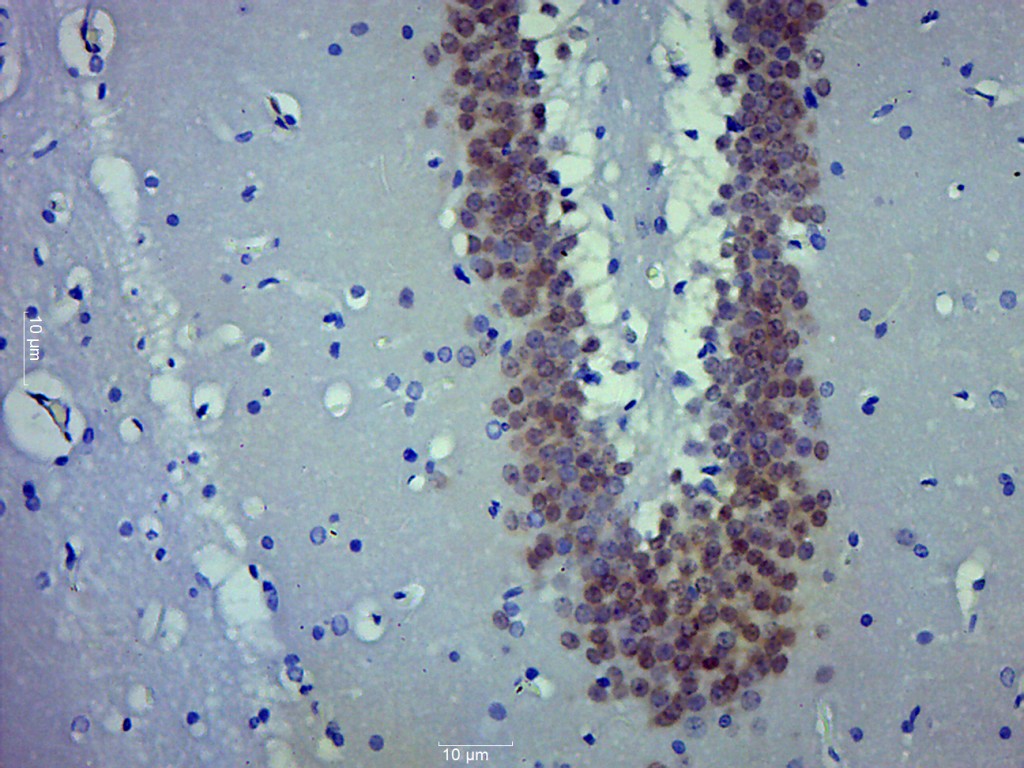
Paraformaldehyde fixed frozen section of adult rat cortex stained with GTX16208 in red and counterstained for DNA in blue. Note that GTX16208 stains neuronal nuclei and distal perikarya. These antibodies do not bind to the nuclei of perikarya of non-neuronal cells, so that they can be used to identify neurons.
NeuN antibody
GTX16208
ApplicationsImmunoFluorescence, Western Blot, ImmunoCytoChemistry, ImmunoHistoChemistry, ImmunoHistoChemistry Frozen
Product group Antibodies
ReactivityBovine, Chicken, Equine, Human, Mouse, Porcine, Rat
TargetRBFOX3
Overview
- SupplierGeneTex
- Product NameNeuN antibody
- Delivery Days Customer9
- Application Supplier NoteWB:1:5,000-1:10,000. IF/IHC 1:500-1:1,000.
- ApplicationsImmunoFluorescence, Western Blot, ImmunoCytoChemistry, ImmunoHistoChemistry, ImmunoHistoChemistry Frozen
- CertificationResearch Use Only
- ClonalityPolyclonal
- ConjugateUnconjugated
- Gene ID146713
- Target nameRBFOX3
- Target descriptionRNA binding fox-1 homolog 3
- Target synonymsFOX-3, FOX3, HRNBP3, NEUN, RNA binding protein fox-1 homolog 3, RNA binding protein, fox-1 homolog 3, fox-1 homolog C, hexaribonucleotide binding protein 3, neuN antigen, neuronal nuclei antigen
- HostRabbit
- IsotypeIgG
- Protein IDA6NFN3
- Protein NameRNA binding protein fox-1 homolog 3
- Scientific DescriptionThis gene encodes a member of the RNA-binding FOX protein family which is involved in the regulation of alternative splicing of pre-mRNA. The protein has an N-terminal proline-rich region, an RNA recognition motif (RRM) domain, and a C-terminal alanine-rich region. This gene produces the neuronal nuclei (NeuN) antigen that has been widely used as a marker for post-mitotic neurons. This gene has its highest expression in the central nervous system and plays a prominent role in neural tissue development and regulation of adult brain function. Mutations in this gene have been associated with numerous neurological disorders. Alternative splicing of this gene results in multiple transcript variants encoding distinct isoforms. [provided by RefSeq, May 2017]
- ReactivityBovine, Chicken, Equine, Human, Mouse, Porcine, Rat
- Storage Instruction-20°C or -80°C,2°C to 8°C
- UNSPSC12352203
References
- Feng L, Chao J, Zhang M, et al. Developing a human iPSC-derived three-dimensional myelin spheroid platform for modeling myelin diseases. iScience. 2023,26(11):108037. doi: 10.1016/j.isci.2023.108037Read this paper
- Manet C, Mansuroglu Z, Conquet L, et al. Zika virus infection of mature neurons from immunocompetent mice generates a disease-associated microglia and a tauopathy-like phenotype in link with a delayed interferon beta response. J Neuroinflammation. 2022,19(1):307. doi: 10.1186/s12974-022-02668-8Read this paper
- Chao J, Feng L, Ye P, et al. Therapeutic development for Canavan disease using patient iPSCs introduced with the wild-type ASPA gene. iScience. 2022,25(6):104391. doi: 10.1016/j.isci.2022.104391Read this paper









